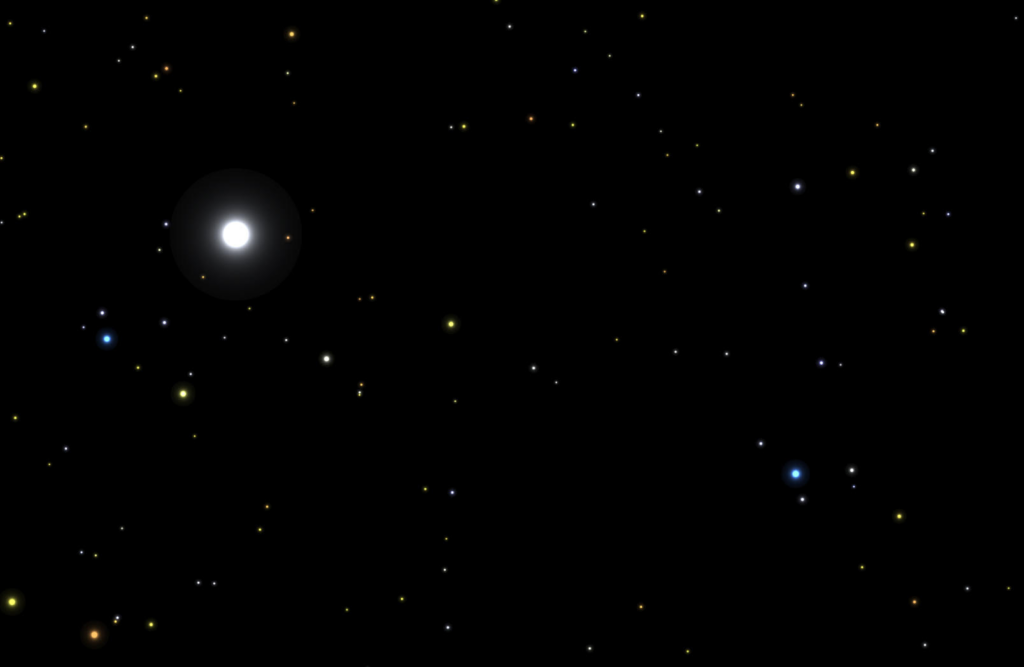Sky Report: November 21-27

Jupiter is the brightest object and Neptune is blue, to its lower right. The graphic shows Neptune too bright; in reality Neptune is 3X fainter than the four stars. near it. Neptune is actually blue but you won’t see its color without a telescope. Graphic created with SkySafariAstronomy.com
This week we’re back to planets, with a challenge! Read on.
Three bright planets are in the evening sky. Don’t take this for granted – in a few months there will be none. In order of brightness they are Jupiter, Mars, and Saturn.
Jupiter is the brightest thing in the night sky other than the moon, and its half-way up the southern sky at 8 p.m. Jupiter is in western Pisces, the Fish, but that won’t help you locate it because Pisces is a large scraggly constellation with no bright stars. Jupiter will help you locate Pisces but not the other way around.
Mars is half as bright as Jupiter but that’s still brighter than every star in the sky, and it’s distinctly orange in color. At the same time – 8:00 — it’s almost a third of the way up the eastern sky, in Taurus, to the upper left of Orion which is beginning to rise. The earth is catching Mars on an inside orbit and we’ll be closest to it next month.
Saturn is as bright as the brighter stars but it’s in Capricornus, which has no stars brighter than Saturn, so it’s not hard to identify. It’s the same altitude as Mars at 8:00, and it’s 40° — 4 times the width of your fist at arm’s length – to the lower right of Jupiter.
Often people are delighted when I show them the planet Neptune through my telescope because few people have ever seen it. This week I’ll show you how you can find it yourself, with binoculars, as a challenge. I believe you can.
Neptune is not far from Jupiter, and that’s what makes this exercise possible. Neptune is to the right of Jupiter and 6° away, which is about the field-of-view of typical binoculars.
First, center your binoculars on Jupiter and look for the 4 fairly bright stars that form an arc below and to the right of it. These stars in Pisces are theoretically bright enough to see without binoculars if you have excellent eyesight and a very dark sky, but they let us establish the scale of the sky near Jupiter. We start with something simple.
Now put Jupiter at the left edge of your binoculars and look at the right edge for a different pattern of 4 faint stars in two short parallel lines, as in the graphic. Or draw a line through the right-most star of the four in that arc and continue in that direction. Then center on those 4 stars. Neptune is mid-way between the 2 stars at left. The graphic shows Neptune as blue and brighter than the stars but in reality the 4 stars are all nearly equal in brightness and they’re all a bit brighter than Neptune. You have “star-hopped” to Neptune. Now take in what it is you’ve done — and congratulate yourself!
Uranus is up there too, between Mars and Jupiter, but it’s not near anything bright that will lead you to it.
Stellar Vista Observatory provides portable telescopes and tripod mounted binocular kits on loan for free to residents and visitors in Kane County. Enhance your enjoyment of the night sky! For details or to request a loan, visit https://stellarvistaobservatory.org/discover-the-night-sky/ or drop in to the Kane County Office of Tourism.
The Sky Report is presented as a public service by the Stellar Vista Observatory, a nonprofit organization based in Kanab, Utah, which provides opportunities for people to observe, appreciate, and comprehend our starry night sky. Additional information is at www.stellarvistaobservatory.org. Send questions and comments to John@StargazingAdventures.org.
John Mosley was Program Supervisor of the Griffith Observatory in Los Angeles for 27 years and is the author of “Stargazing for Beginners” and “Stargazing with Binoculars and Telescopes”. He and his wife live in St. George where he continues to stargaze from his retirement home while serving on the advisory committee for Stellar Vista Observatory.





Comments are closed.